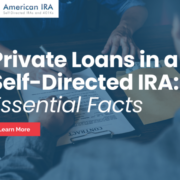Private Equity Investing – A Primer for Self-Directed IRA Investors
Many people we speak to are unaware that the Self-Directed IRA and other retirement accounts are flexible enough to allow for all kinds of different asset classes. You do not have to limit your thinking to stocks, bonds, mutual funds and CDs. You can leverage the substantial tax advantages of Self-Directed IRAs while investing in a wide variety of alternative asset classes. And one of the more lucrative and popular asset classes in recent years has been private equity.
If you are new to private equity investing – especially within a Self-Directed IRA – here is a list of the most common terms.
Private equity is stock ownership that is not listed on a public exchange. These are not necessarily corporations; Private equity ownership is not necessarily limited to C Corporations. Some private equity opportunities are formed as limited partnerships and LLCs.
Occasionally, the term is used to the purchase of a publicly-traded company by investors who then take it private in order to unlock shareholder value or minimize the likelihood of outside interference from activist shareholders.
It is entirely legal to own most private equity investments within a Self-Directed IRA, provided you do not own S Corporations, nor take direct ownership in a prohibited investment class, such as life insurance policies, collectibles, art, jewelry and gemstones, certain forms of gold and precious metal coin and bullion of uncertain or insufficient purity, and assets purchased from a prohibited party (yourself, your spouse, ascendants or descendants, and from professionals who advise you on your Self-Directed IRA in fiduciary capacity.)
As a Self-Directed IRA investor, you can hold shares in specialized private equity or venture capital funds, or you can choose to seek out your own investment opportunities and hold them directly, either within or outside of your Self-Directed IRA.
Primary capital raises. An initial round of funding by selling an equity interest to private buyers, rather than floating shares on a public exchange. When a private equity fund does this, they typically package a series of investments as a ‘blind pool.’ Owners typically hope to sell the investment for several times what they paid for it. But assets are often tied up in the investment for a number of years. Furthermore, risk is high throughout the private equity world. Many investments can and do lose money.
Secondary raises. These are follow-on rounds of capital raising designed to provide additional capital to enable a company to continue on a growth path. Time horizons before expected capital return are much shorter than with primary capital raises.
Private equity investing is not for novice investors. Unlisted securities may not have much in the way of a prospectus. Investors have little recourse when it comes to unregistered securities. But the high risk is the key to market-beating returns. However, whether you invest directly in a company via a private equity offering or you invest in the asset class via a fund, you should conduct a thorough due diligence before you invest.
Interested in learning more about Self-Directed IRAs? Contact American IRA, LLC at 866-7500-IRA (472) for a free consultation. Download our free guides or visit us online at www.AmericanIRA.com.





